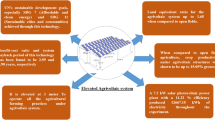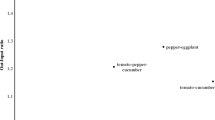Abstract
In this paper, economic feasibility of two vegetable crops (i.e., cucumber and tomato) cultivated in a naturally ventilated greenhouse, and the net present worth, cost-benefit ratio, payback period, and internal rate of return for these crops on year-round cultivation are presented. The cost-benefit ratio demonstrated that growing cucumbers and tomatoes can be economically viable in this climatic region. The present experimental study was conducted in the composite climatic condition of Udaipur (24°35′N, 73°42′E), India. The study area is defined as arid and semi-arid region of Indian climatic conditions. Droughts are a recurring phenomenon in arid and semi-arid regions creating a situation that affects not only agricultural productivity but also people’s health. In particular, the western part of the state is a desert, and its socioeconomic status influences nutrient purchasing power. A poor diet can lead to a vitamin and mineral deficiency. The state of Rajasthan has good agricultural potential; interventions using protected cultivation practices can increase the production and productivity of vegetable crops. However, the current adoption rate of such practices in the state remains very slow, even after a promotional scheme offered by the state government. The government and policymakers should consider offering demonstrations of practices at a larger level. Farmers of the state are marginal and economically poor, requiring more financial assistance. Low cost technologies would be suitable for these farmers.



Similar content being viewed by others
References
Alhamdan AM, Al-Helal IM (2009) Mechanical deterioration of polyethylene greenhouses covering under arid conditions. J Mater Process Technol 209:63–69
Al-Helal IM, Alhamdan AM (2009) Effect of arid environment on radiative properties of greenhouse polyethylene cover. Sol Energy 83:790–798
Bansal NK, Bhattacharya A (2009) Parametric equations for energy and load estimations for buildings in India. Appl Therm Eng 29:3710–3715
Bansal NK, Minke G (1995) Climatic zones and rural housing in India. Forschungszentrum Juelich, Germany ISBN: 3-89336-162-6
Bao-Zhong Y, Sun J, Kang Y, Nishiyama S (2006) Response of cucumber to drip irrigation water under a rainshelter. Agric Water Manag 81(1–2):145–158
Black MJ, Whittaker C, Hosseini SA, Diaz-Chavez R, Woods J, Murphy RJ (2011) Life cycle assessment and sustainability methodologies for assessing industrial crops, processes and end products. Ind Crops Prod 34:1332–1339
Burton-Freeman B, Reimers K (2011) Tomato consumption and health: emerging benefits. Am J Lifestyle Med 5(2):182–191
Canakci M, Akinci I (2006) Energy use pattern analyses of greenhouse vegetable production. Energy 31:1243–1256
Charles H, Godfray J, Beddington JR, Crute IR, Haddad L, Lawrence D, Muir JF, Pretty J, Robinson S, Thomas SM, Toulmin C (2010) Food security: the challenge of feeding: billion people. Science 327(5967):812–818
Food and Agriculture Organization (1996) Declaration on world food security. World Food Summit, FAO, Rome
Giacomelli G, Castilla N, Vanhenten E, Mears D, Sase S (2008) Innovation in greenhouse engineering. Acta Hortic 801:75–88 (adopted from Cabeltitz CV. Integrated Greenhouse system for mild climates. Springer Heidelberg Dordrecht 2011. ISBN: 9783642145810)
Hanafi A, Papasolomontos A (1999) Integrated production and protection under protected cultivation in the Mediterranean region. Biotechnol Adv 17:183–203
Indira Devi P (2007) Pesticide use in the rice bowl of Kerala: health costs and policy options. SANDEE working paper No. 20–07, p 40. http://www.sandeeonline.org/uploads/documents/publication/764_PUB_workingpaper_20_indira.pdf. Retrieved 19 July 2012
Kandpal TC, Grag HG (2003) Financial evaluation of renewable energy technology. Macmillan India Ltd., Delhi
Keatinge JDH, Yang R-Y, Hughes Jd’A, Easdown WJ, Holmer R (2011) The importance of vegetables in ensuring both food and nutritional security in attainment of the millennium development goals. Food Sec 3:491–501
Kothari S, Panwar NL (2004) Evaluation of Greenhouse for cultivation of Babachi. Indian Farm 54(6):16–18
Kothari S, Rathore NS, Panwar NL (2001) Techno economics of greenhouse for cultivation of aswagandha under composite climate of Udaipur. Agric Eng Today 25(3–4):36–40
Kothari S, Kaushik SC, Mathur AN (2006) Greenhouse Science and Technology. Himanshu Publication, Udaipur, India. ISBN. 8179061256
Kristjanson P, Mango N, Krishna A, Radeny M, Johnson N (2010) Understanding poverty dynamics in Kenya. J Int Dev 22(7):978–996
Lozano G, Gonzalez D, Santos E (1996) Growing lettuce in greenhouses clad with polychromatic films. Plasticulture 110:15–22
Martin A (2012) The plastic portal available on http://www.plasticseurope.org/use-of-plastics/agriculture.aspx. Retrieved 19 July 2012
Mohammadi A, Omid M (2010) Economical analysis and relation between energy inputs and yield of greenhouse cucumber production in Iran. Appl Energy 87:191–196
Mukhopadhyay SK, Chattopadhyay A, Chakraborty I, Bhattacharya I (2011) Crops that feed the world. 5. Sweetpotato. Sweetpotatoes for income and food security. Food Secur 3(3):283–305
Nelson GC, Rosegrant MW, Palazzo A, Gray I, Ingersoll C, Robertson R, Tokgoz S, Zhu T, Sulser TB, Ringler C, Msangi S, You L (2010) Food security, farming, and climate change to 2050: scenarios, results, policy options. International Food Policy Research Institute, Washington
Panwar NL, Kothari S, Rathore NS (2009) Protected cultivation of medicinal plant in composite climate of Indian State Rajasthan. Am Eurasian J Agric Environ Sci 5(5):633–637
Singh MB, Lakshminarayana J, Fotedar R (2006). Studies on the nutritional status of rural population in desert area of rajasthan. In: Proceeding of national symposium, held at Jabalpur during October 19–20, 2006
Soni AL, Singh RN, Gupta BD (1980) Nutritional disorders in rural Rajasthan. Indian J Pediat 47:199–202
Tiwari PC, Joshi B (2012) Natural and socio-economic factors affecting food security in the Himalayas. Food Sec 4:195–207
Yamano T, Otsuka K, Place F (2011) Emerging development of agriculture in East Africa: markets, soil and innovation. Springer, Dordrecht
Yang R-Y, Hanson PM, Lumpkin TA (2007) Better health through horticulture—AVRDC’s approach to improved nutrition of the poor. Acta Horticulturae 744:71–77
Zimmer AZ, Leonardi B, Miron D, Schapoval E, Oliverira JR, Gosmann G (2012) Antioxidant and anti-inflammatory properties of Capsicum baccatum: from traditional use to scientific approach. J Ethnopharmacol 139(1):228–233
Acknowledgments
The author (N. L. Panwar) gratefully acknowledges Maharana Pratap University of Agriculture and Technology, Udaipur (Rajasthan), India, and Indian Institute of Technology, Delhi, for sponsorship under the quality improvement program of the Government of India. The financial support extended by Indian Council of Agricultural Research, Govt. of India is gratefully acknowledged.
Author information
Authors and Affiliations
Corresponding author
Rights and permissions
About this article
Cite this article
Panwar, N.L., Kothari, S. & Kaushik, S.C. Cost-benefit and systems analysis of passively ventilated solar greenhouses for food production in arid and semi-arid regions. Environ Syst Decis 34, 160–167 (2014). https://doi.org/10.1007/s10669-013-9438-5
Published:
Issue Date:
DOI: https://doi.org/10.1007/s10669-013-9438-5




